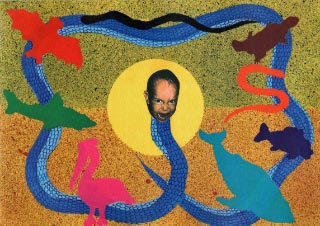‘Rak Niwili’ presents Aboriginal cultural understanding to a wide-ranging audience from preschool age through adults. For the youngest, the story celebrates Rak Niwili’s first year birthday by welcoming his family members, each travelling with their individual Ngukume (Dreaming) such as the platypus, humpback whale and flying fox. They bring birthday presents and are anticipating with great excitement singing, dancing and celebrating together at Manley, Sydney on Guringai country.
Each double page features a family member travelling to the celebration while opposite Rak Niwili sings various refrains welcoming them and revealing their home. The song and various refrains appear at the back of the book. Rak Niwili gleefully chants, ‘It’s my birthday I am one year old today. Hip Hip Hip Hooray! Hey!
Family members come from far and wide: the Torrens River, Yorke Peninsula, Murray River, Broken River, Moyle River and the Coorong. These locations feature on two large maps locating the cultural groups, plus a traditional land map of language groups featuring Australian animals and an image symbolising each family member’s journey to Manley.
This book offers customs to explore and ideas to discuss to gain an understanding of land, culture and language. Included are details for older children and adults about the impact of the British entering the land occupied by the Aboriginal people living there and how this affected the Aboriginal culture and the land. The book is multi-levelled and would be best explored in an educational setting. The book was conceived as a project funded by the Aboriginal Education Strategic Initiatives Program under the National Aboriginal and Torres Strait Islander Education Policy through the Department of Employment, Education and Training.
There are many individuals involved in the creation of this book, and their backgrounds are provided. A major creator is Pilawuk, a Ngangiwumerri woman from Malfyin, along the Moyle River, in the Northern Territory. During a writer in residence session at the National Museum of Australia, Pilawuk read a children’s book she had written about her son, which included a musical tape. This is the published book.

